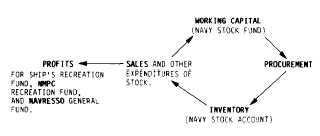| |
Consult NAVSUP P-487 for the details you
should include in these requests. You should
remember that the restrictions that have been
imposed on you are not intended to stifle your
initiative. If you submit a request properly, you
will normally receive approval from NAVRESSO.
Prohibited Items
You are strictly prohibited from procuring
certain merchandise for your ship’s store. For
example, any items that bear the impression of
U.S. currency are prohibited merchandise. You
cannot procure these items for your ship’s store.
You are also prohibited from procuring special
occupational and environmental clothing and
textile (cog symbol 9D) items unless you have
received written authorization from the Com-
mander, Naval Supply Systems Command. In
addition, you are especially prohibited from
purchasing or selling through your ship’s store any
medical items such as drugs, remedies, vitamins,
or other similar products for the external or
internal treatment of diseases or conditions.
STOCK CONTROL
The ability of your ship’s store to support the
needs of your ship will largely depend upon how
well you, as a senior Ship’s Serviceman, handle
the responsibilities of stock control. To develop
and maintain effective stock control, you should
review your inventory control records and make
your scheduled monthly review of all stock and
stock records. These reviews provide fundamental
knowledge with which all responsible ship’s store
personnel must be familiar in order to develop and
maintain effective stock control. Your efforts in
stock control are important because your ship’s
store does not have an unlimited amount of
money to invest in stock. Carrying excess stock
will cause you to waste valuable storeroom space
that might be used for other materials. Frequently,
this type of waste results in a decrease in sales.
On the other hand, if an adequate supply of
material is not in stock, a decrease in sales will
also occur. There is an optimum stock level you
should achieve that will minimize the loss of sales
that would result from these problems. Main-
tenance of an optimum stock level is the primary
purpose for your scheduled monthly review of the
inventory control records and the stock record
cards.
To appreciate the importance of effective
stock control, you must first understand how the
flow of money and materials in the Navy resale
system affects your ship’s store afloat. The follow-
ing diagram represents the system.
The cycle begins with WORKING CAPITAL
(Navy Stock Fund [NSF] money) which is used
to procure your ship’s store stock. PROCURE-
MENT of ship’s store stock determines the
amount of INVENTORY. SALES of ship’s store
stock then replenish your WORKING CAPITAL.
In addition to replenishing your WORKING
CAPITAL for the cost value of the items sold,
SALES also generate your PROFITS. Your PRO-
FITS are determined by the markup over cost that
was applied to the various items sold in the ship’s
store.
As a ship’s store manager, you will use as your
optimum stock level an anticipated 90 days’
supply of stock. If you exceed this amount, you
are tying up too much Navy Stock Fund money
in your ship’s store inventories, for only so much
NSF money is allocated on a Navy-wide basis for
inventories. On the other hand, your failure to
maintain sufficient stocks on board will ultimately
result in decreased sales.
A sales-stock ratio is computed to determine
your efficiency in maintaining your optimum
stock level over a given period of time. As stated
in the NAVSUP P-487, you should maintain a
1.33 to 1 ratio of sales at cost price to your
beginning inventory (less standard clothing items)
per each 4-month accounting period. In other
words, a W-day supply of stock should “turn
over” 1 1/3 times in a 120-day (or 4-month)
accounting period. You can obtain your stock
figure by dividing your cumulative expenditures
for the number of months covered by the
beginning inventory. You will read more about
the actual calculation of your computation of
your stock turn figure later in chapter 7. For now,
however, the following example of various sales
4-4
|

